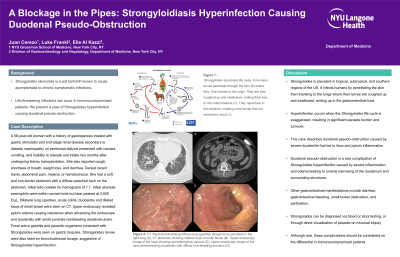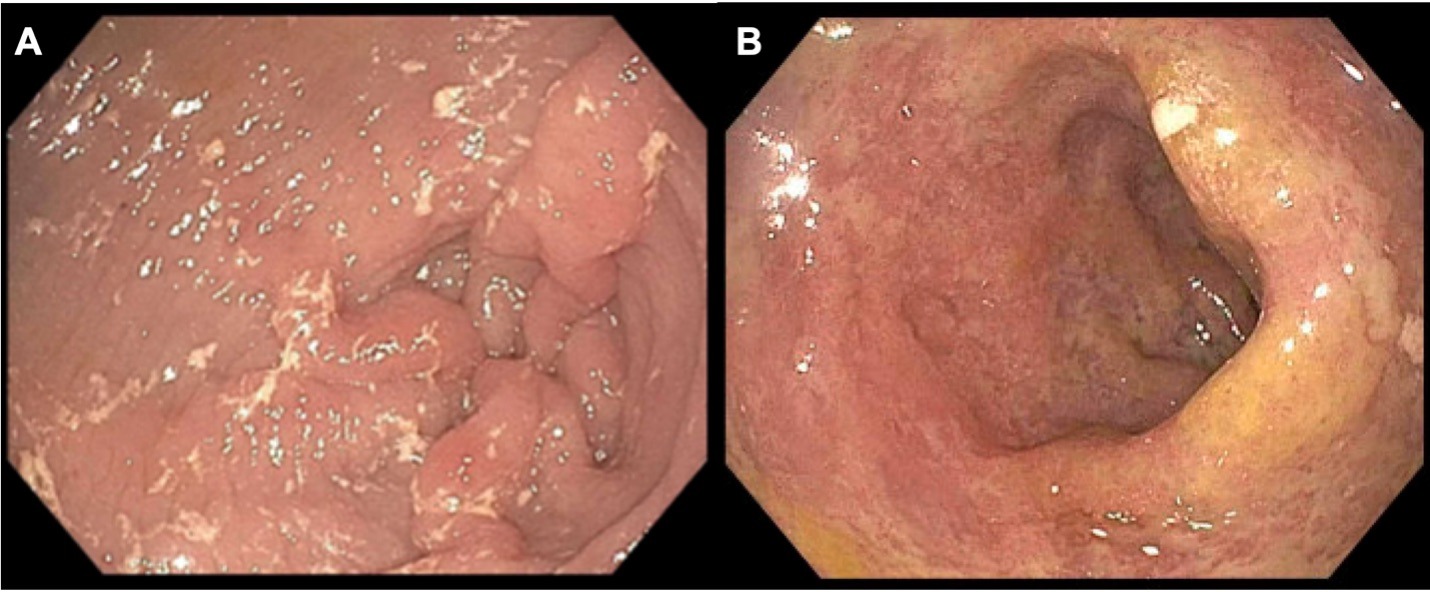Monday Poster Session
Category: General Endoscopy
P2409 - A Blockage in the Pipes: Strongyloidiasis Hyperinfection Causing Duodenal Pseudo-Obstruction
Monday, October 28, 2024
10:30 AM - 4:00 PM ET
Location: Exhibit Hall E

Has Audio

Juan Cerezo, MD
NYU Grossman School of Medicine
New York, NY
Presenting Author(s)
Juan Cerezo, MD1, Luke Frankl, MD1, Elie Al Kazzi, MD, MPH2
1NYU Grossman School of Medicine, New York, NY; 2NYU Langone Health, New York, NY
Introduction: Strongyloides stercoralis is a soil helminth known to cause asymptomatic to chronic symptomatic infections. Life-threatening infections can occur in immunocompromised patients. We present a case of Strongyloides hyperinfection causing duodenal pseudo-obstruction.
Case Description/Methods: A 58-year-old woman with a history of gastroparesis treated with gastric stimulator and end-stage renal disease secondary to diabetic nephropathy on peritoneal dialysis presented with nausea, vomiting, and inability to tolerate oral intake two months after undergoing kidney transplantation. She also reported cough, shortness of breath, weight loss, and diarrhea. Denied recent travel, abdominal pain, melena, or hematochezia. She had a soft and non-tender abdomen with a diffuse petechial rash on the abdomen. Bilateral lung opacities, acute colitis, duodenitis and dilated loops of small bowel were seen on CT. Upper endoscopy revealed pyloric edema causing resistance when advancing the endoscope and duodenitis with small punctate nonbleeding duodenal ulcers. Focal active gastritis and parasitic organisms consistent with Strongyloides were seen on gastric biopsies. Strongyloides larvae were also seen on bronchoalveolar lavage, suggestive of Strongyloides hyperinfection.
Treatment with subcutaneous ivermectin led to clearance of Strongyloides and resolution of post-prandial nausea and vomiting.
Discussion: Strongyloides is prevalent in tropical, subtropical, and southern regions of the US. It infects humans by penetrating the skin then traveling to the lungs where their larvae are coughed up and swallowed, ending up in the gastrointestinal tract. Hyperinfection occurs when this life cycle is exaggerated, resulting in significant parasite burden and turnover.
This case describes duodenal pseudo-obstruction caused by severe duodenitis that led to ileus and pyloric inflammation. Duodenal pseudo-obstruction is a rare complication of Strongyloides hyperinfection caused by severe inflammation and edema leading to luminal narrowing of the duodenum and surrounding structures. Other gastrointestinal manifestations include diarrhea, gastrointestinal bleeding, small bowel obstruction, and perforation. Strongyloides can be diagnosed via blood or stool testing, or through direct visualization of parasite on mucosal biopsy. Although rare, these complications should be considered on the differential in immunocompromised patients.

Disclosures:
Juan Cerezo, MD1, Luke Frankl, MD1, Elie Al Kazzi, MD, MPH2. P2409 - A Blockage in the Pipes: Strongyloidiasis Hyperinfection Causing Duodenal Pseudo-Obstruction, ACG 2024 Annual Scientific Meeting Abstracts. Philadelphia, PA: American College of Gastroenterology.
1NYU Grossman School of Medicine, New York, NY; 2NYU Langone Health, New York, NY
Introduction: Strongyloides stercoralis is a soil helminth known to cause asymptomatic to chronic symptomatic infections. Life-threatening infections can occur in immunocompromised patients. We present a case of Strongyloides hyperinfection causing duodenal pseudo-obstruction.
Case Description/Methods: A 58-year-old woman with a history of gastroparesis treated with gastric stimulator and end-stage renal disease secondary to diabetic nephropathy on peritoneal dialysis presented with nausea, vomiting, and inability to tolerate oral intake two months after undergoing kidney transplantation. She also reported cough, shortness of breath, weight loss, and diarrhea. Denied recent travel, abdominal pain, melena, or hematochezia. She had a soft and non-tender abdomen with a diffuse petechial rash on the abdomen. Bilateral lung opacities, acute colitis, duodenitis and dilated loops of small bowel were seen on CT. Upper endoscopy revealed pyloric edema causing resistance when advancing the endoscope and duodenitis with small punctate nonbleeding duodenal ulcers. Focal active gastritis and parasitic organisms consistent with Strongyloides were seen on gastric biopsies. Strongyloides larvae were also seen on bronchoalveolar lavage, suggestive of Strongyloides hyperinfection.
Treatment with subcutaneous ivermectin led to clearance of Strongyloides and resolution of post-prandial nausea and vomiting.
Discussion: Strongyloides is prevalent in tropical, subtropical, and southern regions of the US. It infects humans by penetrating the skin then traveling to the lungs where their larvae are coughed up and swallowed, ending up in the gastrointestinal tract. Hyperinfection occurs when this life cycle is exaggerated, resulting in significant parasite burden and turnover.
This case describes duodenal pseudo-obstruction caused by severe duodenitis that led to ileus and pyloric inflammation. Duodenal pseudo-obstruction is a rare complication of Strongyloides hyperinfection caused by severe inflammation and edema leading to luminal narrowing of the duodenum and surrounding structures. Other gastrointestinal manifestations include diarrhea, gastrointestinal bleeding, small bowel obstruction, and perforation. Strongyloides can be diagnosed via blood or stool testing, or through direct visualization of parasite on mucosal biopsy. Although rare, these complications should be considered on the differential in immunocompromised patients.

Figure: Figure 1: Edematous pylorus (A) and duodenitis with diffuse non-bleeding erosions (B).
Disclosures:
Juan Cerezo indicated no relevant financial relationships.
Luke Frankl indicated no relevant financial relationships.
Elie Al Kazzi indicated no relevant financial relationships.
Juan Cerezo, MD1, Luke Frankl, MD1, Elie Al Kazzi, MD, MPH2. P2409 - A Blockage in the Pipes: Strongyloidiasis Hyperinfection Causing Duodenal Pseudo-Obstruction, ACG 2024 Annual Scientific Meeting Abstracts. Philadelphia, PA: American College of Gastroenterology.
